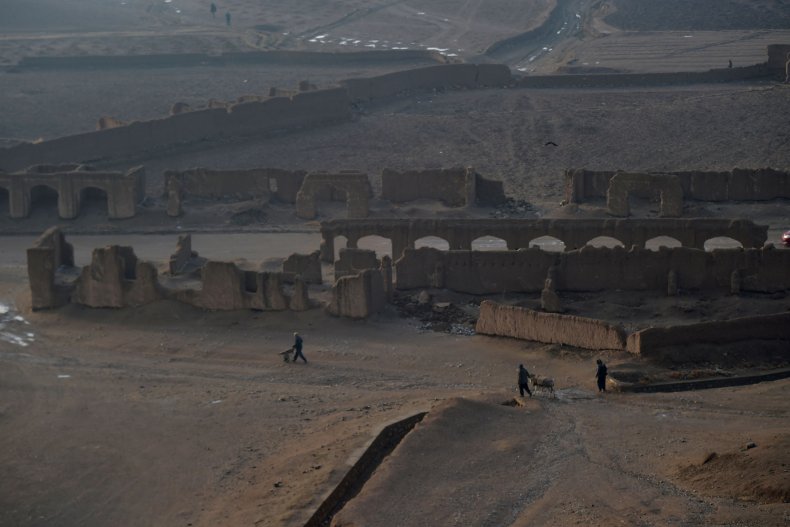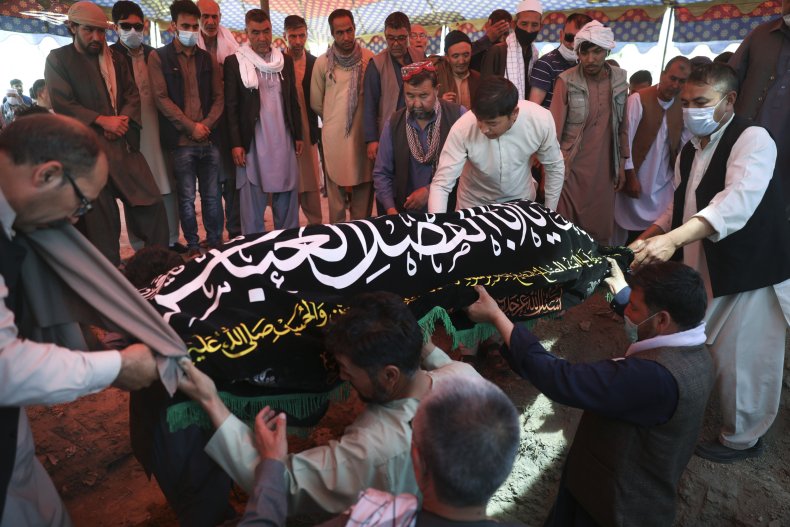BY MARY ELLEN CAGNASSOLA
As violence in Afghanistan increases amid U.S. and NATO troop withdrawal, the country's Hazara ethnic group are arming themselves against what they anticipate will be a war for control between opposing factions competing for control.
Hazaras are vulnerable targets at schools, weddings, mosques, sports clubs, and even at birth. Afghanistan's Islamic State affiliate declared war on the country's Shiites in 2014 and 2015 and has claimed responsibility for recent attacks on the Hazaras.
The Hazara community is also deeply skeptical of the government for its lack of incentive to protect them. Some hold concerns over government-linked warlords, who antagonize the ethnic group, being involved in the attacks.
 Hazara men walk along a path near the site of the Buddhas of Bamiyan statues, which were destroyed by the Taliban in 2001, in Bamiyan province on March 14, 2021.WAKIL KOHSAR/VIA GETTY IMAGES
Hazara men walk along a path near the site of the Buddhas of Bamiyan statues, which were destroyed by the Taliban in 2001, in Bamiyan province on March 14, 2021.WAKIL KOHSAR/VIA GETTY IMAGESJust running errands in the mainly Hazara neighborhoods of west Kabul can be dangerous. One day last week, Adila Khiari and her two daughters went out to buy new curtains. Soon after, her son heard that a minibus had been bombed—the fourth to be blown up in just 48 hours.
When his mother didn't answer her phone, he frantically searched hospitals in the Afghan capital. He found his sister Hosnia in critical condition with burns over 50 percent of her body. Then he found his mother and his other sister, Mina, both dead. Three days later, on Sunday, Hosnia died as well.
Inside the Nabi Rasool Akram Mosque compound, protected by sandbags stacked against its ornate doors and 10-foot high walls, Qatradullah Broman was among the Hazaras attending the funeral of Adila and Mina this week.
The government doesn't care about Hazaras and has failed to protect them, he said. "Anyone who can afford to leave, they are leaving. Those who can't are staying here to die," said Broman. "I see a very dark future for our people."
Former government adviser Torek Farhadi told The Associated Press that within the political leadership, "from the top down," there is a "sorry culture" of discrimination against Hazaras. "The government, in a cynical calculation, has decided Hazara lives are cheap," he said.
Since 2015, attacks have killed at least 1,200 Hazaras and injured another 2,300, according to Wadood Pedram, executive director of the Kabul-based Human Rights and Eradication of Violence Organization.
Last year, gunmen attacked a maternity hospital in the mainly Hazara districts of west Kabul. When the shooting ended, 24 people were dead, including newborns and their mothers. Last month, a triple bombing at the Syed Al-Shahada school in the same area killed nearly 100 people, mostly Hazara schoolgirls. This week, when militants attacked a compound of de-mining workers, shooting and killing at least 10, witnesses said the attackers tried to pick Hazaras out of the workers to kill.
Some of these attacks, deliberately targeting civilians, hospitals and children, could rise to the level of war crimes, said Patricia Gossman, associate director for Asia at Human Rights Watch.
Pedram's organization has petitioned the UN Human Rights Commission to investigate the killing of Hazaras as genocide or a crime against humanity. It and other rights groups also helped the International Criminal Court in 2019 compile suspected war crimes cases in Afghanistan.
"The world doesn't speak about our deaths. The world is silent. Are we not human?" said Mustafa Waheed, an elderly Hazara weeping at the burial of Mina and her mother.
A black velvet cloth inscribed in gold with Quranic verses was draped over the two bodies. Family and friends carried them on wooden beds, then placed them inside the graves. Mina's father fell to the ground crying.
"The U.S. can go into space, but they can't find out who is doing this?" Waheed said. "They can see an ant move from space, but they can't see who is killing Hazaras?"
In the face of the killings, talk has turned to arming Hazara youth to defend the community, particularly in the districts that the community dominates in western Kabul. Some Hazaras say the May 8 attack on the Syed al-Shahada school was a turning point.
It is a significant reversal for a community that showed such hope in a new Afghanistan. After the fall of the Taliban, many Hazara militias gave up their weapons under a government disarmament program, even as other factions were reluctant.
"We used to think the pen and the book were our greatest weapon, but now we realize it is the gun we need," said Ghulam Reza Berati, a prominent Hazara religious leader. Fathers of the girls killed in the school attack are being told to invest in weapons, said Berati, who helped bury many of the girls.
Sitting on the carpets of west Kabul's Wali Asar Mosque, Berati said Hazaras are disappointed in the democracy brought by the U.S.-led coalition. Hazaras have largely been excluded from positions of prominence, he said.
Hazaras worry about continuing IS attacks and about the potential return of the Taliban to power after the American withdrawal. But they also worry about the many heavily armed warlords who are part of the government. Some of them carried out violence against Hazaras in the past, and Hazaras fear they will do so again if post-withdrawal Afghanistan slides into a repeat of the brutal inter-factional civil war of the early 1990s.
 Afghan Hazaras attend the funeral of Mina Khiari, who was killed in a bombing last week, in Kabul, Afghanistan, Saturday, June 5, 2021. After the collapse of the Taliban 20 years ago, Afghanistan's ethnic Hazaras began to flourish and soon advanced in various fields, including education and sports, and moved up the ladder of success. They now fear those gains will be lost to chaos and war after the final withdrawal of American and NATO troops from Afghanistan this summer.RAHMAT GUL/AP PHOTO
Afghan Hazaras attend the funeral of Mina Khiari, who was killed in a bombing last week, in Kabul, Afghanistan, Saturday, June 5, 2021. After the collapse of the Taliban 20 years ago, Afghanistan's ethnic Hazaras began to flourish and soon advanced in various fields, including education and sports, and moved up the ladder of success. They now fear those gains will be lost to chaos and war after the final withdrawal of American and NATO troops from Afghanistan this summer.RAHMAT GUL/AP PHOTOOne warlord who is still prominent in Kabul, Abdul Rasool Sayyaf, led a Pashtun militia that massacred Hazara civilians during a ferocious 1993 battle with Hazara militias in Kabul's mainly Hazara neighborhood of Afshar.
Rajab Ali Urzgani became a sort of folk hero in his community as one of the youngest Hazara commanders during the Battle of Afshar—only 14 at the time.
Now 41 and still known by his nom de guerre, Mangol, he returned to Afshar earlier this month with the AP to visit the site. He stopped to give a prayer for the dead at a mass grave where nearly 80 men, women and children were killed in the bloodshed are buried. A black Shiite banner flies at the entrance.
Mangol held out little hope for peace in Afghanistan following the U.S. and NATO withdrawal.
"When the foreigners withdraw, the war will happen 1,000 percent," he said. "The war will happen like in the past with the different groups, and we will defend our family and our dignity."
No comments:
Post a Comment